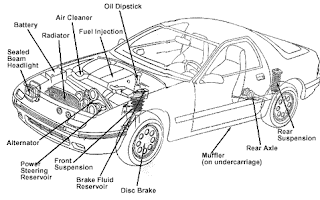THE logic behind combining electric and internal combustion propulsion is that the traditional powerplant is inefficient because at cruise speed, it is only using part of the power it produces and therefore the excess power should be used to generate electricity for use later.
So far they have proven their worth as a way for car companies to develop battery and electric motor technology and for motorists to get used to the new technology. The recent New York and Shanghai Motor Show has seen the launch of several new hybrid and electric vehicles, some in concept form and others in production trim.
Suzuki came up with the Kizashi Ecocharge Concept which pairs a 144 horsepower 2.0-litre engine with a belt-driven 15 kilowatt (20hp) motor-generator that delivers added torque on acceleration.
The belt-driven motor-generator replaces the alternator and starter, which means that it's mounted parallel to the driveline. In the Kizashi Ecocharge, the six-speed transmission is mounted conventionally behind the engine.
The motor-generator rechargers the car's 0.5-kilowatt-hour lithium-ion battery pack that is mounted in the trunk.
As well as delivering additional torque, the motor-generator also recharges the car's air-cooled 0.5-kilowatt-hour lithium-ion battery pack during regenerative braking. The pack is mounted in the trunk.
Meanwhile Audi has been toying with the idea of electric cars for the past few months, the latest being the A3 e-tron.
This is a plug-in hybrid drivetrain with range extender motor. A plug-in hybrid usually relies on their electric motor to move while the internal combustion engine is assigned as battery charger and electricy generator.
However on the A3 e-tron, the petrol engine also provides power directly to the wheels.
The A3 e-tron is powered by a turbocharged 1.4-liter TFSI gasoline engine generating 211 hp and matched to a lightweight 20kW (27hp) electric motor. Audi claims the motor is strong enough to power the hefty 1.5-tonne concept for a distance of up to 65 kilometres, emissions free.
It's powered by a 12 kWh lithium-ion battery that can be charged using a regular household power outlet.
Working together, the gasoline engine and electric motor accelerate the concept to 100 from rest in 6.8 seconds and see it reaches a top speed of 240km/h.
Since electric cars and hybrids are more expensive than normal cars, some manufacturers lease out the cars rather than sell them - for example, the Nissan Leaf is leased for USD$349 per month while the Chevrolet Volt costs USD$350 per month.
Meanwhile, BMW is planning to lease its 1-series-based ActiveE which can be in your garage for USD$499 per month, after putting down a USD$2,250 downpayment. Like its predecessor, the Mini E, the ActiveE is only a test vehicle, in this case built to let BMW test new liquid-cooled lithium-ion battery technology and a 125-kilowatt (170-hp) drive motor.
Source link: http://www.mmail.com.my/content/70197-hybrids-galore-electrics-lease
So far they have proven their worth as a way for car companies to develop battery and electric motor technology and for motorists to get used to the new technology. The recent New York and Shanghai Motor Show has seen the launch of several new hybrid and electric vehicles, some in concept form and others in production trim.
Suzuki came up with the Kizashi Ecocharge Concept which pairs a 144 horsepower 2.0-litre engine with a belt-driven 15 kilowatt (20hp) motor-generator that delivers added torque on acceleration.
The belt-driven motor-generator replaces the alternator and starter, which means that it's mounted parallel to the driveline. In the Kizashi Ecocharge, the six-speed transmission is mounted conventionally behind the engine.
The motor-generator rechargers the car's 0.5-kilowatt-hour lithium-ion battery pack that is mounted in the trunk.
As well as delivering additional torque, the motor-generator also recharges the car's air-cooled 0.5-kilowatt-hour lithium-ion battery pack during regenerative braking. The pack is mounted in the trunk.
Meanwhile Audi has been toying with the idea of electric cars for the past few months, the latest being the A3 e-tron.
This is a plug-in hybrid drivetrain with range extender motor. A plug-in hybrid usually relies on their electric motor to move while the internal combustion engine is assigned as battery charger and electricy generator.
However on the A3 e-tron, the petrol engine also provides power directly to the wheels.
The A3 e-tron is powered by a turbocharged 1.4-liter TFSI gasoline engine generating 211 hp and matched to a lightweight 20kW (27hp) electric motor. Audi claims the motor is strong enough to power the hefty 1.5-tonne concept for a distance of up to 65 kilometres, emissions free.
It's powered by a 12 kWh lithium-ion battery that can be charged using a regular household power outlet.
Working together, the gasoline engine and electric motor accelerate the concept to 100 from rest in 6.8 seconds and see it reaches a top speed of 240km/h.
Since electric cars and hybrids are more expensive than normal cars, some manufacturers lease out the cars rather than sell them - for example, the Nissan Leaf is leased for USD$349 per month while the Chevrolet Volt costs USD$350 per month.
Meanwhile, BMW is planning to lease its 1-series-based ActiveE which can be in your garage for USD$499 per month, after putting down a USD$2,250 downpayment. Like its predecessor, the Mini E, the ActiveE is only a test vehicle, in this case built to let BMW test new liquid-cooled lithium-ion battery technology and a 125-kilowatt (170-hp) drive motor.
Source link: http://www.mmail.com.my/content/70197-hybrids-galore-electrics-lease

No comments:
Post a Comment